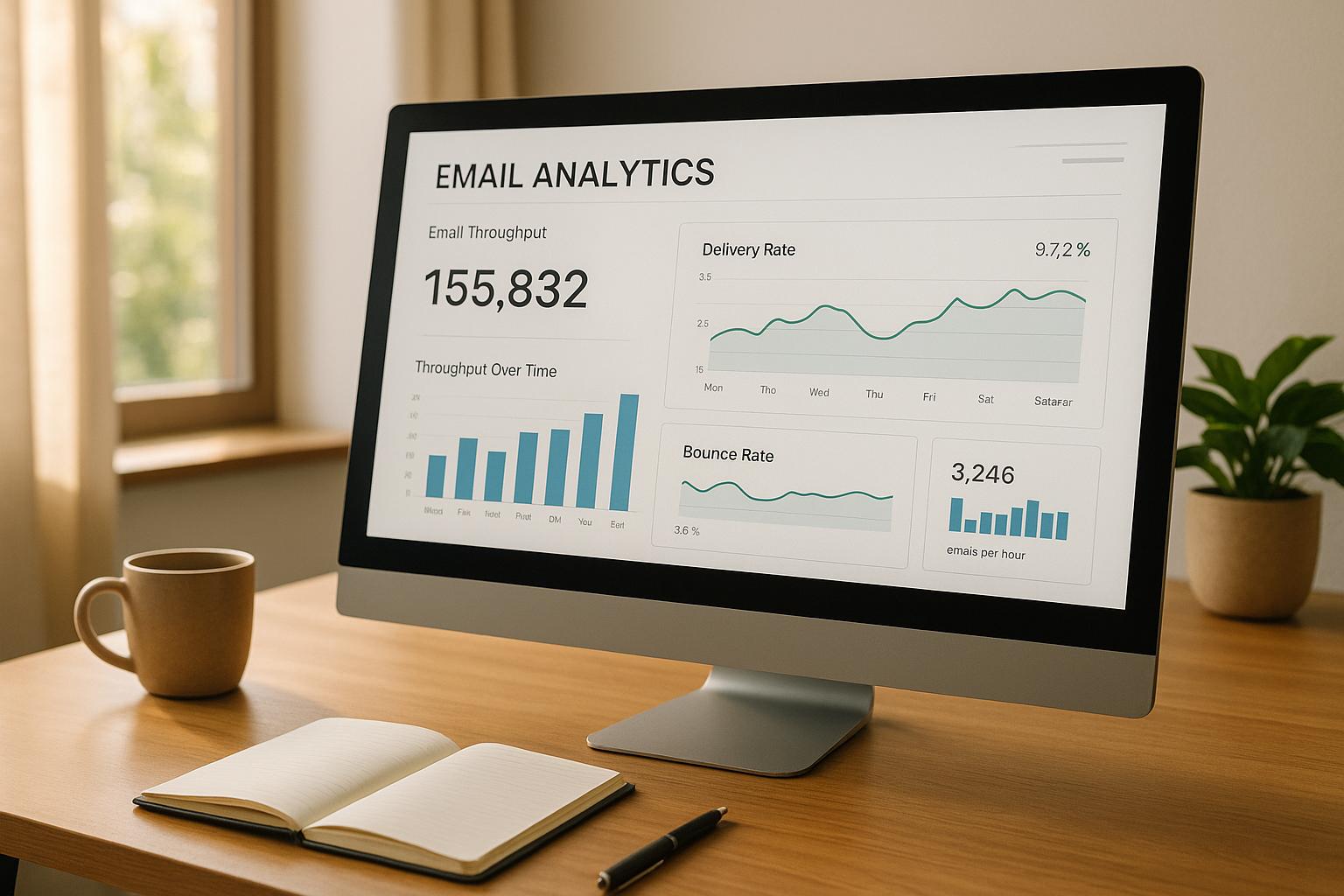Dynamic email content customizes messages for each subscriber, improving engagement and conversions. It uses data like purchase history, browsing behavior, and location to personalize emails in real time. Here's why it works:
- Higher Open Rates: Personalized subject lines can boost open rates by up to 35%.
- Better Engagement: Tailored product recommendations increase click-through rates and revenue (e.g., Adidas saw a 67% revenue jump).
- Streamlined Campaigns: Dynamic templates save time by adjusting content automatically.
Quick Results:
| Metric | Improvement |
|---|---|
| Open Rate | +26% |
| Click-to-Open Rate | +300% |
| Revenue | 6x higher (Dell example) |
| Customer Satisfaction | +30% |
Dynamic content simplifies email marketing while delivering personalized experiences that drive results. Let’s explore how to use it effectively.
Solving Email Marketing Challenges with Dynamic Content
Improving Engagement: Open and Click-Through Rates
Dynamic content can significantly improve how your audience interacts with your emails. For example, personalized subject lines can result in 26% higher open rates, according to Litmus. Dell experienced even more impressive results: a 300% increase in click-to-open rates and a 6x boost in revenue from dynamic campaigns [1].
| Metric | Improvement |
|---|---|
| Click-to-Open Rate | 300% increase |
| Revenue | 6x higher than standard |
| Customer Engagement | Improved relevance |
These numbers highlight how dynamic content helps brands close the gap in personalization.
Overcoming Lack of Personalization
Modern platforms make it easier than ever to create tailored experiences by using data like browsing behavior and purchase history. TUI's use of behavioral recommendations is a great example of this, but Adidas took it even further. In 2023, Adidas used dynamic product recommendations to achieve a 41% increase in click-through rates and a 67% jump in revenue [3].
Streamlining Campaign Creation
Dynamic content doesn’t just enhance engagement - it also simplifies the process of creating campaigns. Instead of juggling multiple templates, marketers can use a single template with dynamic blocks that adjust automatically based on subscriber data. This approach eliminates the common bottlenecks in campaign creation.
| Campaign Element | Traditional Approach | Dynamic Content Approach |
|---|---|---|
| Template Creation | Multiple versions needed | Single template with dynamic blocks |
| Content Updates | Manual updates for each | Automated updates across all versions |
| Personalization | Basic merge tags only | Advanced logic and automation |
Advantages of Dynamic Content in Email Campaigns
Boosting Engagement and Conversions
Dynamic content delivers results that can’t be ignored. For example, Experian found that personalized emails achieve 6 times higher transaction rates compared to static ones. Zappos saw a 12% rise in cart recovery rates and a 15% increase in average order value by including tailored product suggestions in abandoned cart emails. These outcomes are consistent with Dell’s earlier achievements, proving that dynamic content works across different industries.
Enhancing Customer Experience
Adidas’ use of product recommendations inspired a subscription box service to customize email content based on user preferences. The result? A 30% improvement in customer satisfaction scores. Similarly, TUI focused on creating relevant, personalized experiences to strengthen customer loyalty, showing how tailored content can make a big impact.
Refining Segmentation and Targeting
TUI’s success with behavioral targeting paved the way for others. A fitness app, for instance, increased app engagement by 45% by recommending workouts tailored to users’ activity levels and goals. Dynamic content simplifies this kind of personalization, allowing businesses to create efficient campaigns using unified templates while delivering highly relevant messages.
Dynamic Email Content Explained
sbb-itb-6e7333f
Implementing Dynamic Email Content Effectively
Dynamic content can transform email marketing results, but success hinges on how well it's executed. For instance, a beauty brand boosted repeat purchases by 28% by tailoring product recommendations in emails based on purchase history.
Using Customer Data for Personalization
Focus on the most impactful types of customer data to personalize emails effectively:
| Data Type | Use Case | Impact |
|---|---|---|
| Purchase History | Product recommendations | Encourages repeat purchases |
| Browsing Behavior | Abandoned cart recovery | Improves conversion rates |
| Email Engagement | Send time optimization | Boosts open rates |
| Location Data | Local offers and events | Makes content more relevant |
| Customer Lifecycle | Targeted promotions | Strengthens retention |
To ensure accuracy, validate your data regularly and let users update their preferences through a preference center.
Creating Flexible Email Designs
Take your segmentation efforts further by designing email templates that adapt to various content needs and user preferences. Modular design is the way to go - think of it as building with LEGO blocks, where each block can be swapped or adjusted.
Key components for adaptable email designs:
- Modular content blocks: Independent sections that are easy to update or replace.
- Responsive layouts: Ensure emails look great on any device.
- Dynamic image swapping: Change visuals based on user data, like preferences or past behaviors.
- Fallback content: Use default options when customer-specific data isn't available.
Testing and Refining Dynamic Elements
To get the most out of dynamic content, test and tweak these areas:
- Subject lines
- Product recommendation algorithms
- Best times to send emails
- Placement of content blocks
- Effectiveness of calls-to-action
Keep an eye on open rates, click-through rates, and conversions for each segment. This hands-on, data-driven approach helps you adjust your strategy as customer behaviors and preferences shift.
Evaluating the Effectiveness of Dynamic Content
Once you've implemented dynamic content, keeping track of its performance is essential to ensure continued success and improvement.
Key Performance Indicators to Track
Here are some metrics to help you measure how well your dynamic content is performing:
| Metric | What It Measures | Why It Matters |
|---|---|---|
| Open Rate | Percentage of emails opened vs. total sent | Helps assess how effective your subject lines are |
| Click-Through Rate | Percentage of link clicks vs. emails opened | Indicates how relevant your content is to recipients |
| Conversion Rate | Percentage of desired actions completed | Shows the impact on your goals, like signups or purchases |
| Revenue Per Email | Average revenue generated per email | Highlights the financial returns of your campaigns |
| Unsubscribe Rate | Rate of people leaving your list | Reflects the quality and relevance of your content |
Tracking these metrics can give you a clear picture of engagement and conversion trends, as demonstrated in previous case studies.
Tools for Measurement and Analysis
Most email marketing platforms come with built-in analytics to help you measure dynamic content performance. Depending on your needs, here are some tools to consider:
Basic Analytics Tools:
- Mailchimp's Campaign Reports: Offers detailed insights into email performance.
- Google Analytics: Tracks user behavior on your website.
- Litmus Email Analytics: Provides insights into how emails perform across different clients.
Advanced Measurement Solutions:
- Salesforce Marketing Cloud Einstein: Delivers AI-driven analytics for deeper insights.
- Adobe Analytics: Tracks performance across multiple channels.
- Optimizely: Ideal for advanced A/B testing to fine-tune your content.
Examples of Successful Implementations
One SaaS company saw an 18% increase in trial conversions by using dynamic onboarding emails tailored to user roles and industries. Their results included:
- A 31% rise in click-through rates
- A 12% increase in email revenue over just 90 days
To replicate this kind of success, focus on:
- Ensuring your data is accurate
- Running ongoing A/B tests
- Tracking customer lifetime value trends
- Analyzing behavior across devices
Conclusion: Boosting Email Conversions with Dynamic Content
Key Takeaways
Dynamic content has proven to be a game-changer for email marketing. It tackles common challenges by improving engagement metrics like click-through rates and conversions. For example, personalized subject lines, as Dell has shown, can increase open rates, while behavioral recommendations, as seen with Adidas, drive higher revenue. Supporting this, research from Epsilon highlights that 80% of consumers are more inclined to buy when brands provide tailored experiences [2].
Selecting the Right Tools
Finding the right tools is crucial for effectively implementing dynamic content strategies. Here’s a quick breakdown of available platform types:
| Platform Type | Ideal For |
|---|---|
| Starter Tools | Basic personalization |
| Growth Platforms | Advanced segmentation/testing |
| Enterprise Systems | AI-powered, multi-channel campaigns |
For businesses ready to take the next step, the Email Service Business Directory offers a detailed comparison of email marketing platforms. This resource simplifies the decision-making process, helping organizations match tools to their specific goals and requirements.


